2014 MERCEDES-BENZ B-CLASS SPORTS engine oil
[x] Cancel search: engine oilPage 283 of 360

could otherwise damag
ethe windshield
wiper sorthe hood. X
Make sure that the windshield wiper sare
switched off.
X Pull release lever 001Aon the hood.
The hoo disreleased. X
Reach into the ga pbetween the hoo dand
the radiator trim and press hoo dcatch
lever 0010to the left.
X Raise the hood. X
Pull support strut 0021outofb racket 001E.
X Lift up support strut 0021and insert it into
yellow retaining clip 0023.
Closin gthe hood X
Raise the hoo dslightl yand,att he same
time ,remove support strut 0021from yellow
retaining clip 0023.
X Swing support strut 0021dow nand press it
into bracket 001Eunti lite ngages.
X Lower the hoo dand le titfall from aheight
of approximately 8in(20 cm).
X Chec kthat the hood has engaged properly.
If the hood can be raised slightly, it is not
properly engaged. Do not press the hood
closed. Open the hood again and close it
with alittle more force. Engine oil
General notes Depending on your driving style, the vehicle
consumes up to 0.9 US qt (0.8 liters) of oil per
600 miles (1,000 km). The oil consumption
may be higher than this when the vehicle is
new or if you frequently drive at high engine
speeds.
Depending on the engine, the oil dipstick may
be in
adifferent location.
When checking the oil level:
R park the vehicle on alevel surface.
R the engine should be switched off for
approximately five minutes if the engine is
at normal operating temperature.
R if the engine is not at normal operating
temperature, e.g. if the engine was only
started briefly, wait about 30 minutes
before carrying out the measurement. Engine compartment
281Maintenance and care Z
Page 284 of 360
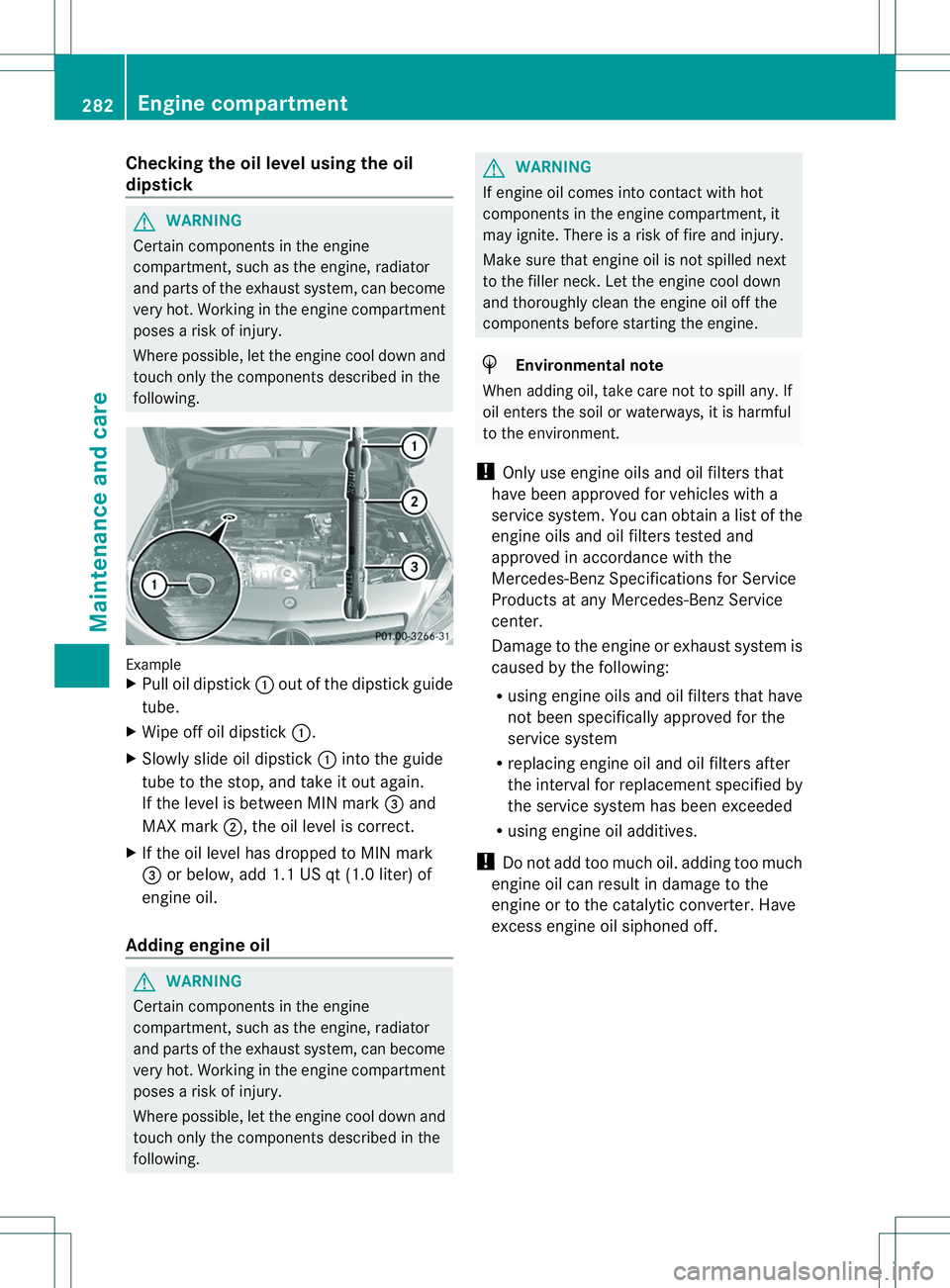
Checking th
eoil level usin gthe oil
dipstick G
WARNING
Certain components in th eengine
compartment, suc hasthe engine, radiator
and parts of the exh austsystem, can become
very hot. Working in the engine compartment
poses arisk of injury.
Where possible, let the engine cool down and
touch only the components described in the
following. Example
X
Pull oil dipstick 001Aout of the dipstick guide
tube.
X Wipe off oil dipstick 001A.
X Slowly slide oil dipstick 001Ainto the guide
tube to the stop, and take it out again.
If the level is between MIN mark 0023and
MAX mark 0010,the oil level is correct.
X If the oil level has dropped to MIN mark
0023 or below, add 1.1 US qt (1.0 liter) of
engine oil.
Adding engine oil G
WARNING
Certain components in the engine
compartment, such as the engine, radiator
and parts of the exhaust system, can become
very hot. Working in the engine compartment
poses arisk of injury.
Where possible, let the engine cool down and
touch only the components described in the
following. G
WARNING
If engine oil comes into contact with hot
components in the engine compartment, it
may ignite. There is arisk of fire and injury.
Make sure that engine oil is not spilled next
to the filler neck.L et the engine cool down
and thoroughly clean the engine oil off the
components before starting the engine. H
Environmental note
When adding oil, take care not to spill any. If
oil enterst he soil or waterways, it is harmful
to the environment.
! Only use engine oils and oil filters that
have been approved for vehicles with a
service system. You can obtain alist of the
engine oils and oil filters tested and
approved in accordanc ewith the
Mercedes-Benz Specifications for Service
Products at any Mercedes-Benz Service
center.
Damage to the engine or exhaust system is
caused by the following:
R using engine oils and oil filters that have
not been specifically approved for the
service system
R replacing engine oil and oil filters after
the interval for replacement specified by
the service system has been exceeded
R using engine oil additives.
! Do not add too much oil. adding too much
engine oil can result in damage to the
engine or to the catalytic converter. Have
excess engine oil siphoned off. 282
Engine compartmentMaintenance and care
Page 285 of 360
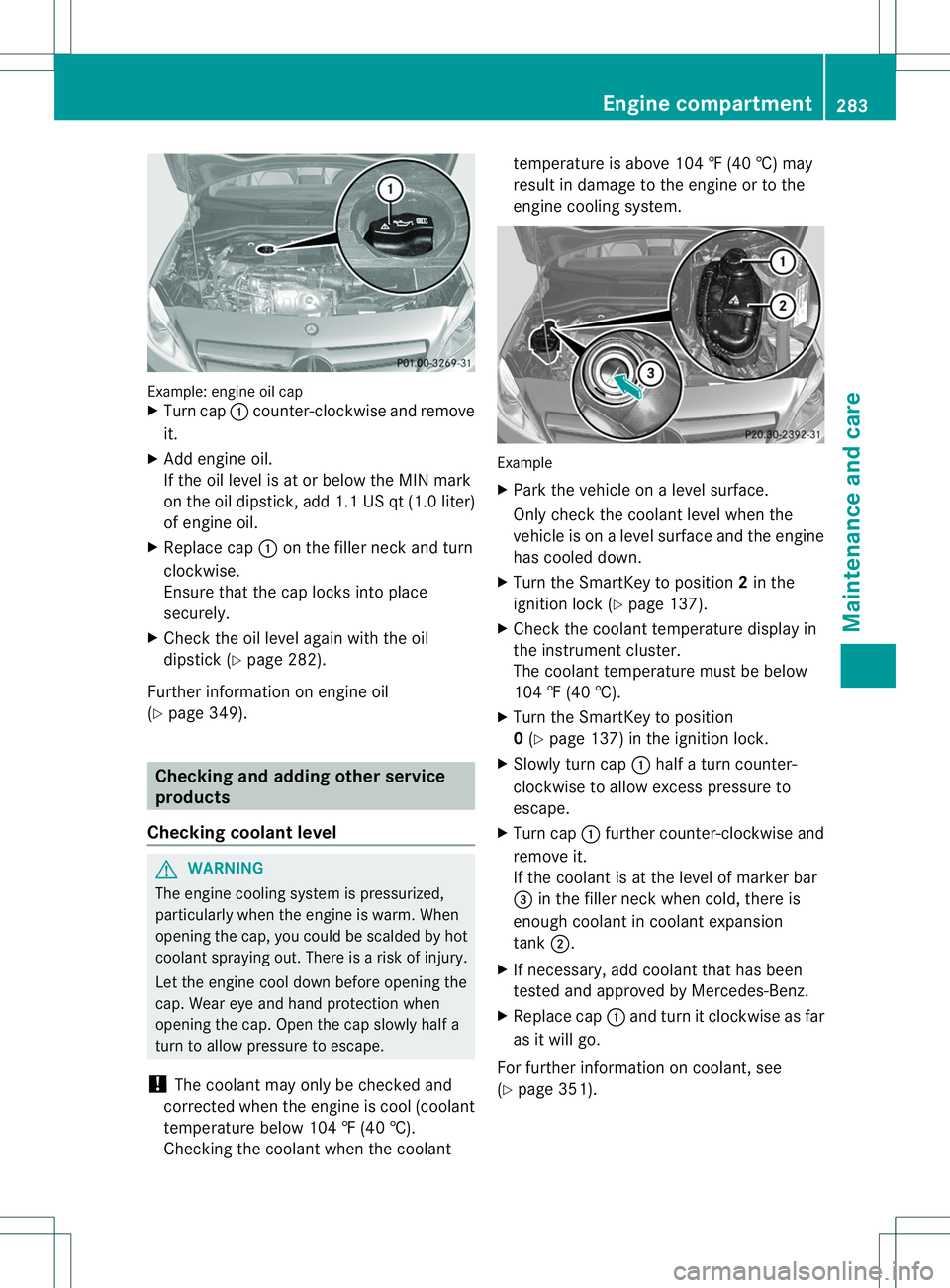
Example: engine oi
lcap
X Turn cap 001Acounter-clockwis eand remove
it.
X Add engine oil.
If the oi llev el is at or belo wthe MIN mark
on the oi ldipstick, ad d1.1 US qt (1.0 liter)
of engine oil.
X Replace cap 001Aon the fille rneck and turn
clockwise.
Ensure tha tthe cap locks into place
securely.
X Check the oi llev el agai nwith the oil
dipstick (Y page 282).
Further information on engine oil
(Y page 349). Checking and adding other service
products
Checking coolant level G
WARNING
The engine cooling system is pressurized,
particularly when the engine is warm. When
opening the cap, you could be scalde dbyhot
coolan tspraying out. There is arisk of injury.
Let the engin ecool down before openin gthe
cap. Wear eye and hand protection when
openin gthe cap. Open the cap slowly half a
turn to allow pressure to escape.
! The coolant may only be checked and
corrected when the engin eiscool (coolant
temperature below 104 ‡(40 †).
Checking the coolant when the coolant temperature is above 104
‡(40 †) may
result in damage to the engine or to the
engine cooling system. Example
X
Park the vehicle on alevel surface.
Only check the coolant level when the
vehicle is on alevel surface and the engine
has cooled down.
X Turn the SmartKey to position 2in the
ignition lock (Y page 137).
X Check the coolant temperature displayin
the instrument cluster.
The coolant temperature must be below
104 ‡(40 †).
X Turn the SmartKey to position
0(Y page 137) in the ignition lock.
X Slowly turn cap 001Ahalf aturn counter-
clockwise to allow excess pressure to
escape.
X Turn cap 001Afurther counter-clockwise and
remove it.
If the coolant is at the level of marker bar
0023 in the filler neck when cold, there is
enough coolant in coolant expansion
tank 0010.
X If necessary, add coolant that has been
tested and approved by Mercedes-Benz.
X Replace cap 001Aand turn it clockwise as far
as it will go.
For further information on coolant, see
(Y page 351). Engine compartment
283Maintenance and care Z
Page 286 of 360
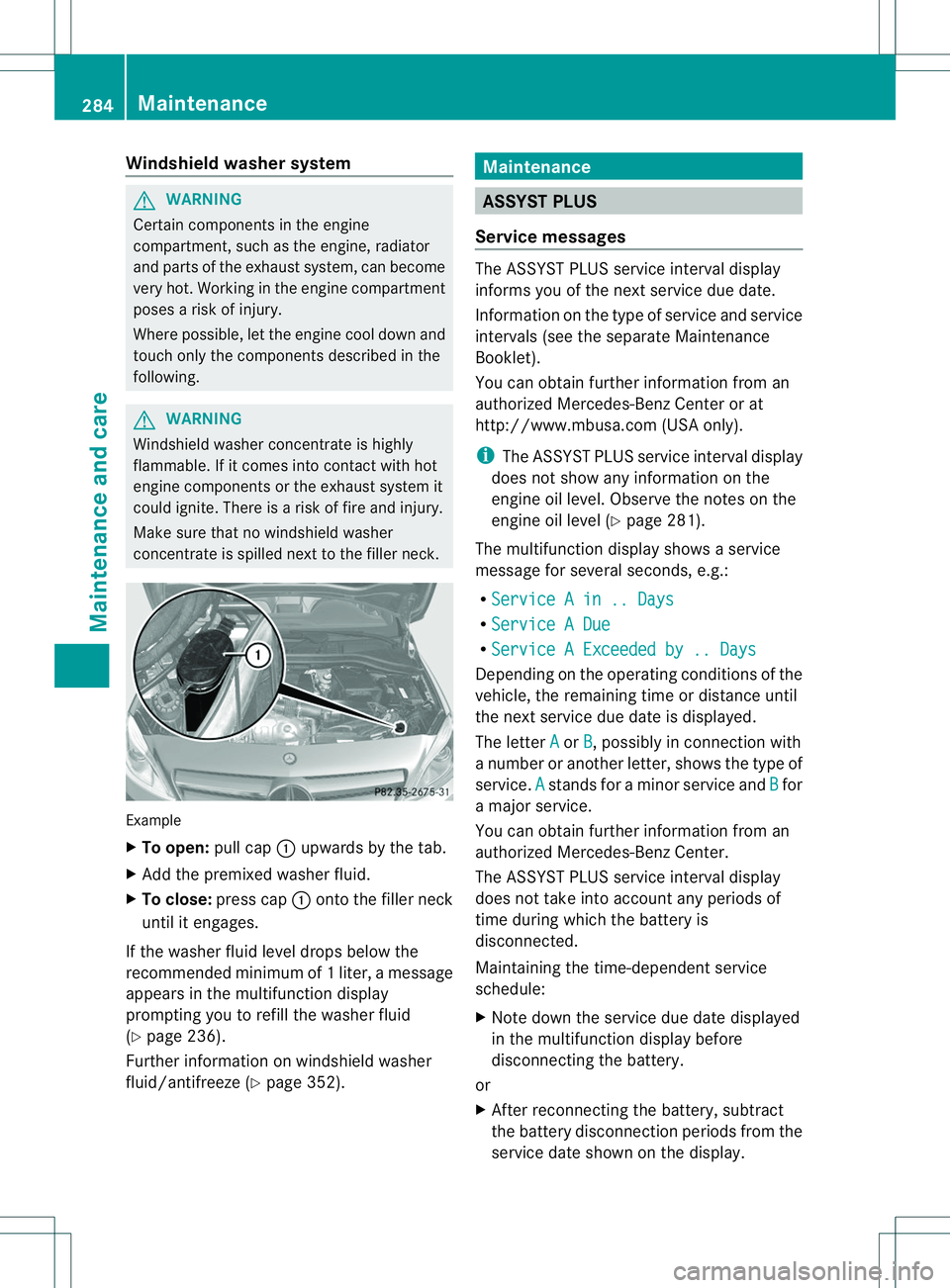
Windshield washe
rsystem G
WARNING
Certain components in the engine
compartment, such as the engine, radiator
and parts of the exhaust system, can become
very hot. Working in the engine compartment
poses arisk of injury.
Where possible, let the engine cool down and
touch only the components described in the
following. G
WARNING
Windshieldw asherconcentrate is highly
flammable. If it comes into contact with hot
engine components or the exhaust system it
could ignite. There is arisk of fire and injury.
Make sure that no windshield washer
concentrate is spilled next to the filler neck. Example
X
To open: pull cap001Aupwards by the tab.
X Add the premixed washer fluid.
X To close: press cap 001Aontot he filler neck
until it engages.
If the washer fluid level drops below the
recommended minimum of 1liter ,am essage
appears in the multifunction display
promptin gyou to refill the washer fluid
(Y page 236).
Further information on windshield washer
fluid/antifreeze (Y page 352). Maintenance
ASSYST PLUS
Service messages The ASSYS
TPLUS service interval display
inform syou of the nex tservice due date.
Information on the type of servic eand service
intervals (see the separate Maintenance
Booklet).
You can obtain further information from an
authorized Mercedes-BenzC enter or at
http://www.mbusa.com (USA only).
i The ASSYST PLUS servic einterva ldisplay
does not sho wany informatio nonthe
engine oil level. Observe the notes on the
engine oil level (Y page 281).
The multifunction displays howsaservice
message for several seconds, e.g.:
R Service Ain..D ays R
Service ADue R
Service AExceeded by .. Days Depending on the operating conditionsoft
he
vehicle, the remaining time or distance until
the next service due date is displayed.
The letter A or
B ,p
ossibly in connection with
an umber or another letter, shows the type of
service. A stands for
aminor service and B for
am ajor service.
You can obtain further information from an
authorized Mercedes-Ben zCenter.
The ASSYST PLUS servic einterval display
does not take intoa ccountany periods of
time during which the battery is
disconnected.
Maintaining the time-dependent service
schedule:
X Note down the servic eduedate displayed
in the multifunctio ndisplay before
disconnecting the battery.
or
X After reconnecting the battery, subtract
the battery disconnection periods fro mthe
service date shown on the display. 284
MaintenanceMaintenance and care
Page 349 of 360
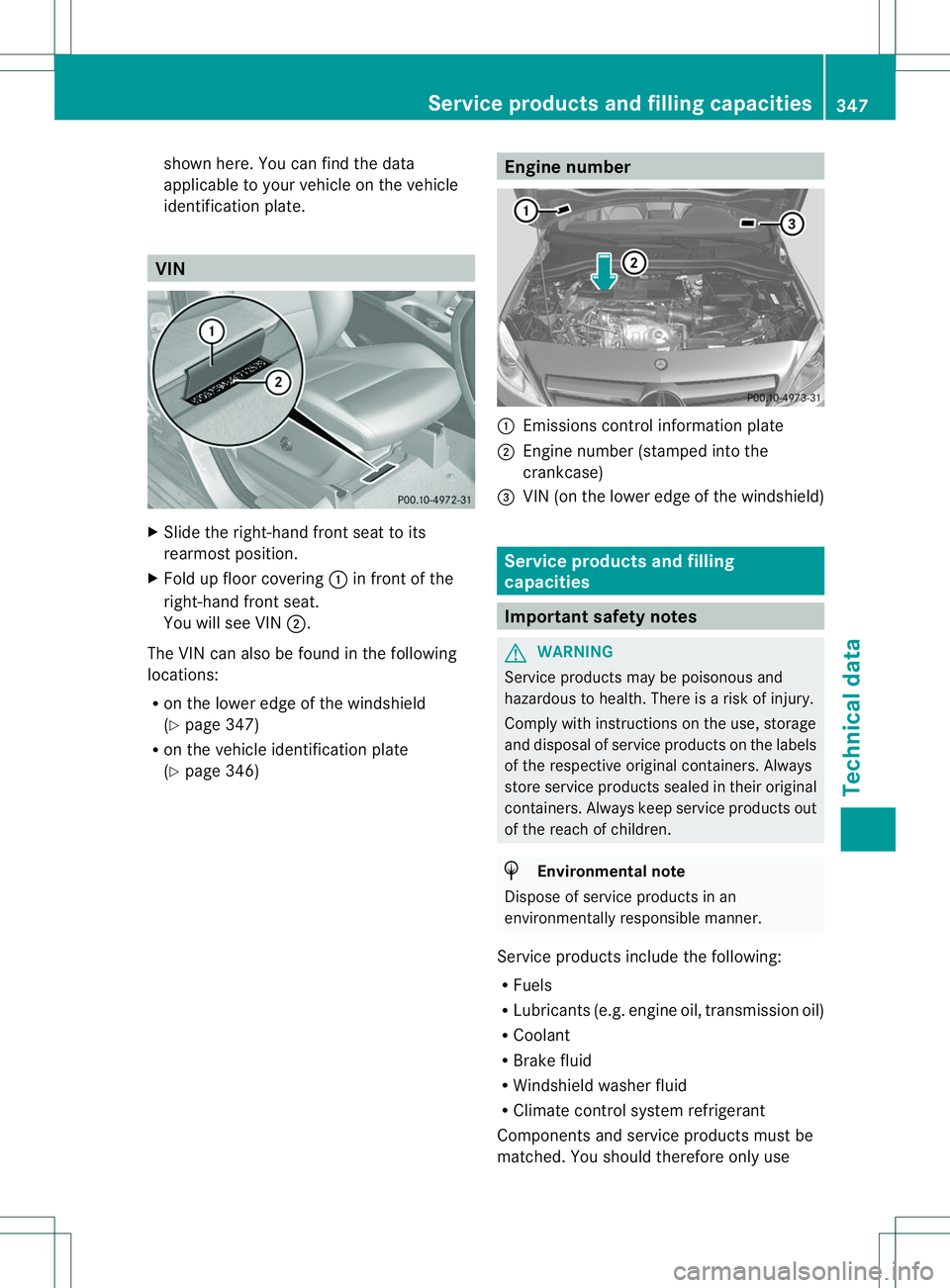
shown here. You can find the data
applicable to your vehicle on the vehicle
identification plate.
VIN
X
Slide the right-hand front seat to its
rearmost position.
X Fold up floor covering 001Ain front of the
right-hand front seat.
You will see VIN 0010.
The VIN can also be found in the following
locations:
R on the lower edge of the windshield
(Y page 347)
R on the vehicle identification plate
(Y page 346) Enginen
umber 001A
Emissions control information plate
0010 Engine number (stamped into the
crankcase)
0023 VIN (on the lower edge of the windshield) Service products and filling
capacities
Important safety notes
G
WARNING
Service products may be poisonous and
hazardous to health. There is arisk of injury.
Comply with instructions on the use, storage
and disposal of service products on the labels
of the respective original containers. Always
store service products sealed in their original
containers. Always keep service products out
of the reach of children. H
Environmental note
Dispose of service products in an
environmentally responsible manner.
Service products include the following:
R Fuels
R Lubricants (e.g. engine oil, transmission oil)
R Coolant
R Brake fluid
R Windshield washer fluid
R Climate control system refrigerant
Components and service products must be
matched. You should therefore only use Service products and filling capacities
347Technical data Z
Page 351 of 360

R
M30 (gasoline with 30% methanol)
R M85 (gasoline with 85% methanol)
R M100 (100% methanol)
R Gasoline with metalliferous additives
R Diesel
Do not mix such fuels with the fuel
recommended for your vehicle. Do not use
additives. This can otherwise lead to engine
damage. This does not include cleaning
additives for the removal and prevention of
residue build-up. gasoline may only be
mixed with cleaning additives
recommended by Mercedes-Benz; see
"Additives". You can obtain further
information from any authorized Mercedes-
Benz Center.
! To ensure the longevity and full
performance of the engine, only premium-
grade unleaded gasoline must be used.
If standard premium-grade unleaded
gasoline is unavailable and unleaded
gasoline of alower grade is used for
refueling, observe the following
precautions:
R only fill the fuel tank to half full with
regular unleaded gasoline and fill the rest
with premium-grade unleaded gasoline
as soon as possible.
R do not drive at the maximum speed.
R avoid sudden acceleration and engine
speeds above 3000 rpm.
R never refuel using fuel with an octane
number lower than 87. Otherwise,
engine failure could occur.
Using mixtures of methanol and ethanol is not
permitted. E10 fuel or E15 fuel (unleaded
gasoline with 10% or 15% ethanol) can be
used.
You will usually find information about the fuel
grade on the pump. If you cannot find the
label on the pump, ask the staff for
assistance.
i For further information ,consult a
qualified specialist workshop or on the Internet at http://www.mbusa.com (USA
only).
Information on refueling (Y page 150).
Additives
! Operating the engine with fuel additives
added later can lead to engine failure. Do
not mix fuel additives with fuel. This does
not include additives for the removal and
prevention of residue buildup. gasoline
must only be mixed with additives
recommended by Mercedes-Benz. Comply
with the instructions for use on the product
label.M ore information about
recommended additives can be obtained
from any authorized Mercedes-Benz
Center.
Mercedes-Benz recommends that you use
fuel brands that have the additives.
The quality of the fuel available in some
countries may not be sufficient .Residue
could build up as aresult. In such cases, and
in consultation with an authorized Mercedes-
BenzC enter, the gasoline may be mixed with
the cleanin gadditive recommended by
Mercedes-Benz( part no. A000989254512).
You must observe the notes and mixin gratios
specified on the container. Engine oil
General notes !
Never use engin eoil or an oil filter of a
specification other than is necessary to
fulfill the prescribed servic eintervals. Do
not change the engine oi loroilfilter in
order to achieve longe rreplacement
intervals than those prescribed. You could
otherwise cause engin edamage or damage
to the exhaust gas aftertreatment.
Follow the instructions in the service
interval display regarding the oil change.
Otherwise, you may damage the engin eand
the exhaust gas aftertreatment. Service products and filling capacities
349Technical data Z
Page 352 of 360
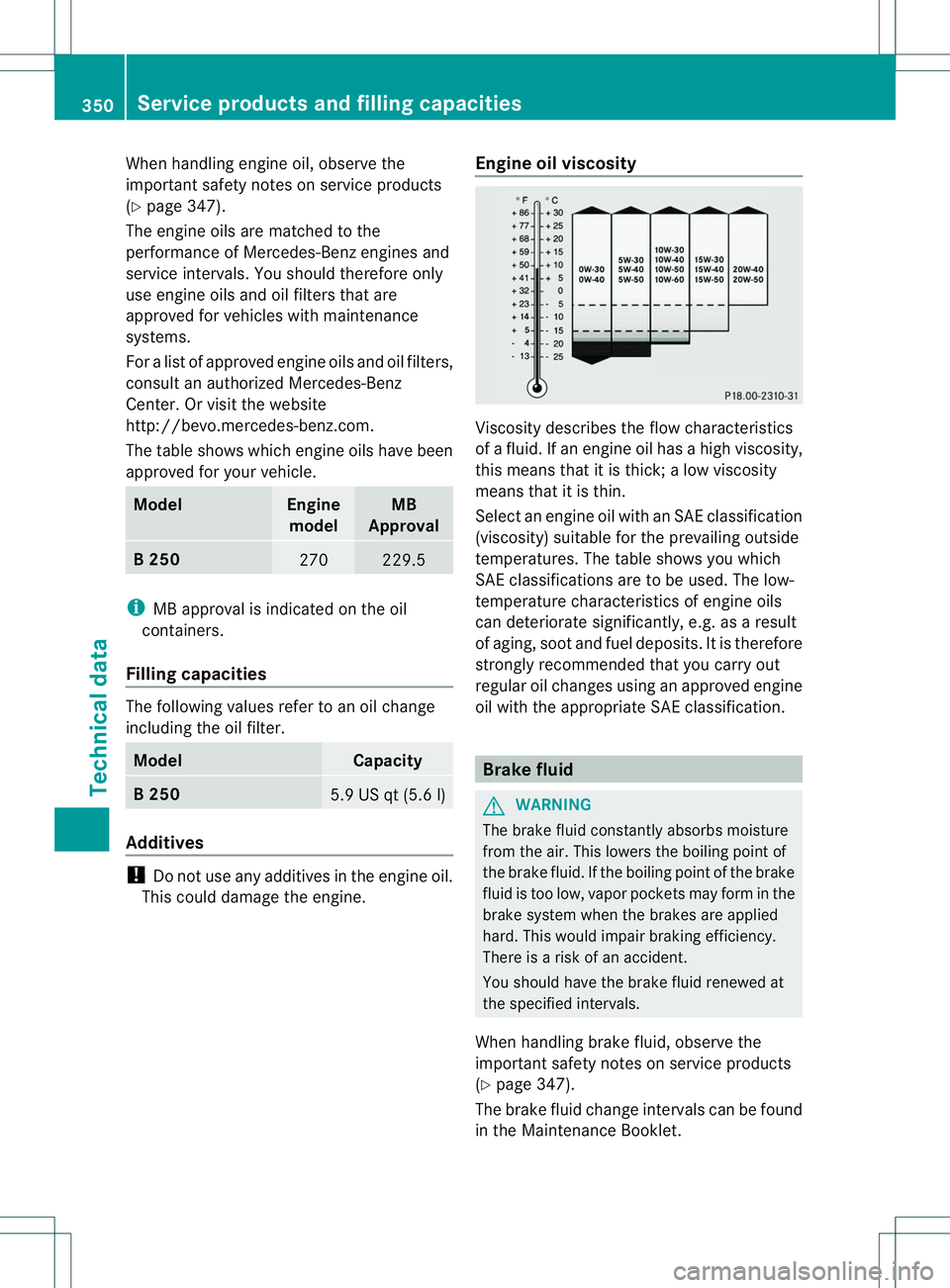
When handling engine oil, observe the
important safety notes on service products
(Y page 347).
The engine oils are matched to the
performance of Mercedes-Benz engines and
service intervals. You should therefore only
use engine oils and oil filters that are
approved for vehicles with maintenance
systems.
For alist of approved engine oils and oil filters,
consult an authorized Mercedes-Benz
Center .Orvisit the website
http://bevo.mercedes-benz.com.
The table shows which engine oils have been
approved for your vehicle. Model Engine
model MB
Approval B2
50 270 229.5
i
MB approval is indicated on the oil
containers.
Filling capacities The following values refer to an oil change
includin
gthe oil filter. Model Capacity
B2
50 5.9 US qt
(5.6 l) Additives
!
Do no tuse any additives in the engine oil.
This could damage the engine. Engineo
il viscosity Viscosity describes the flow characteristics
of
afluid. If an engine oil has ahigh viscosity,
this means that it is thick; alow viscosity
means that it is thin.
Select an engine oil with an SAE classification
(viscosity) suitablef or the prevailing outside
temperatures. The table shows you which
SAE classifications are to be used. The low-
temperature characteristics of engine oils
can deteriorate significantly, e.g. as aresult
of aging, soot and fuel deposits. It is therefore
strongly recommended that you carry out
regularo il changes using an approved engine
oil with the appropriate SA Eclassification. Brake fluid
G
WARNING
The brak efluid constantly absorb smoisture
fro mt he air. This lowers the boiling point of
the brake fluid. If the boiling point of the brake
fluid is too low, vapor pockets may form in the
brake system when the brakes are applied
hard. This would impair braking efficiency.
There is arisk of an accident.
You should have the brake fluid renewed at
the specified intervals.
When handling brake fluid, observe the
important safety notes on service products
(Y page 347).
The brake fluid change intervals can be found
in the MaintenanceB ooklet.350
Service products and fillingc
apacitiesTechnical data
Page 353 of 360
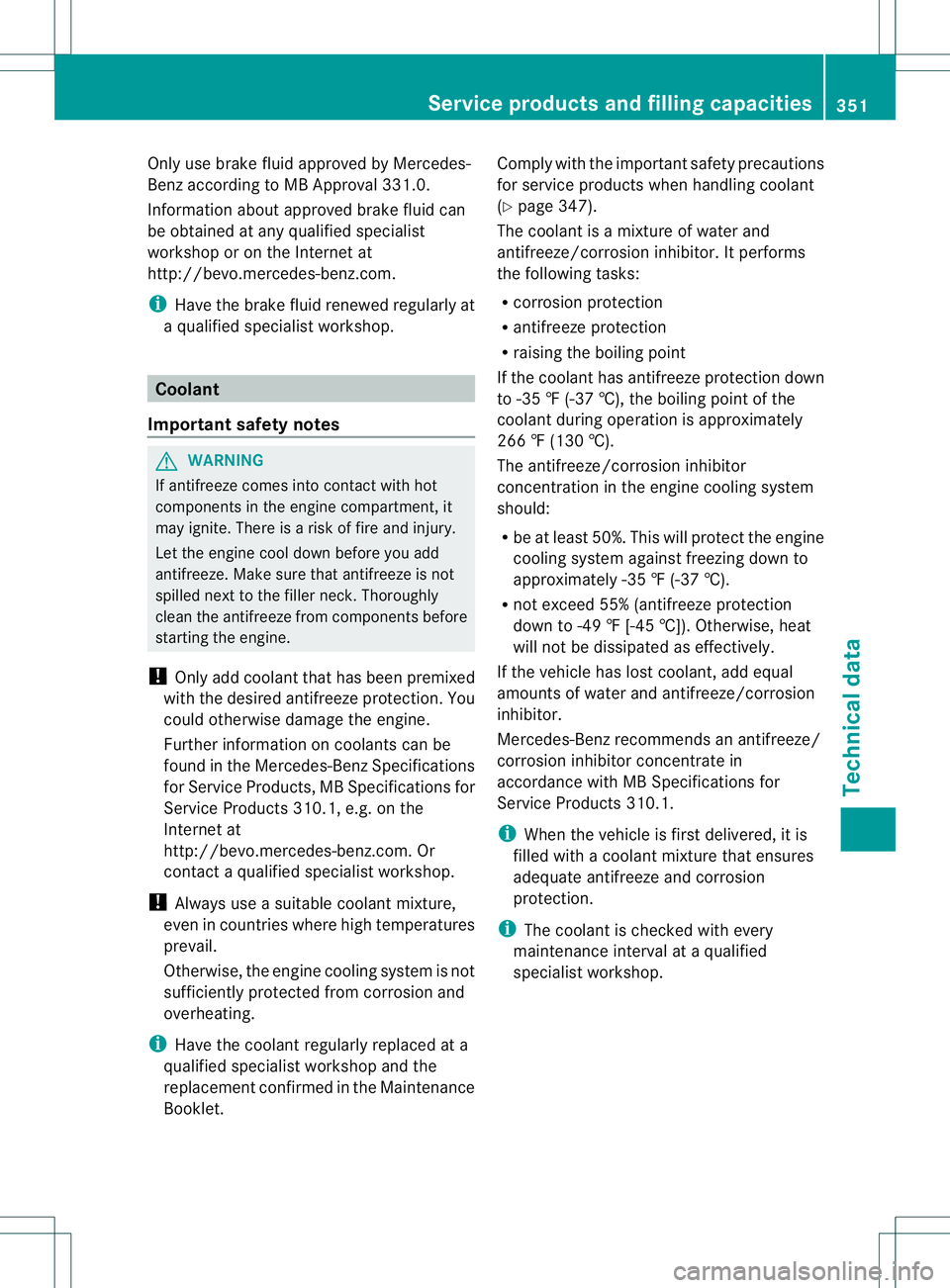
Only use brake fluid approved by Mercedes-
Benz according to MB Approval 331.0.
Information abouta
pproved brake fluid can
be obtaine datany qualified specialist
workshop or on the Internet at
http://bevo.mercedes-benz.com.
i Have the brake fluid renewed regularly at
aq ualified specialist workshop. Coolant
Importan tsafet ynotes G
WARNING
If antifreeze comes int ocontact with hot
component sinthe engin ecompartment ,it
may ignite. There is arisk of fire and injury.
Let the engin ecool down before you add
antifreeze .Make sure that antifreeze is not
spilled nex ttothe filler neck.T horoughly
clean the antifreeze from components before
startingt he engine.
! Only add coolant that has been premixed
with the desired antifreezep rotection. You
coul dotherwise damage the engine.
Further information on coolants can be
found in the Mercedes-Benz Specifications
for Service Products, MB Specifications for
Service Products 310.1, e.g. on the
Internet at
http://bevo.mercedes-benz.com .Or
contact aqualified specialist workshop.
! Always use asuitable coolant mixture,
even in countries where high temperatures
prevail.
Otherwise, the engine cooling system is not
sufficiently protected from corrosio nand
overheating.
i Have the coolant regularl yreplaced at a
qualified specialist workshop and the
replacement confirmed in the Maintenance
Booklet. Comply with the important safety precautions
for service products when handling coolant
(Y
page3 47).
The coolant is amixture of water and
antifreeze/corrosion inhibitor. It performs
the following tasks:
R corrosio nprotection
R antifreeze protection
R raising the boiling point
If the coolant has antifreeze protection down
to -35 ‡(-37 †), the boiling point of the
coolant during operatio nisapproximately
266 ‡(130 †).
The antifreeze/corrosion inhibitor
concentration in the engine cooling system
should:
R be at least 50%. This will protect the engine
cooling system against freezing down to
approximately -35 ‡(-37 †).
R not exceed 55% (antifreeze protection
down to -49 ‡[-45 †]). Otherwise, heat
will not be dissipated as effectively.
If the vehicle has lost coolant, add equal
amounts of water and antifreeze/corrosion
inhibitor.
Mercedes-Benz recommends an antifreeze/
corrosion inhibitor concentrate in
accordance with MB Specifications for
Service Products 310.1.
i When the vehicle is first delivered, it is
filled with acoolant mixture that ensures
adequate antifreeze and corrosion
protection.
i The coolant is checked with every
maintenance interval at aqualified
specialist workshop. Service products and filling capacities
351Technical data Z